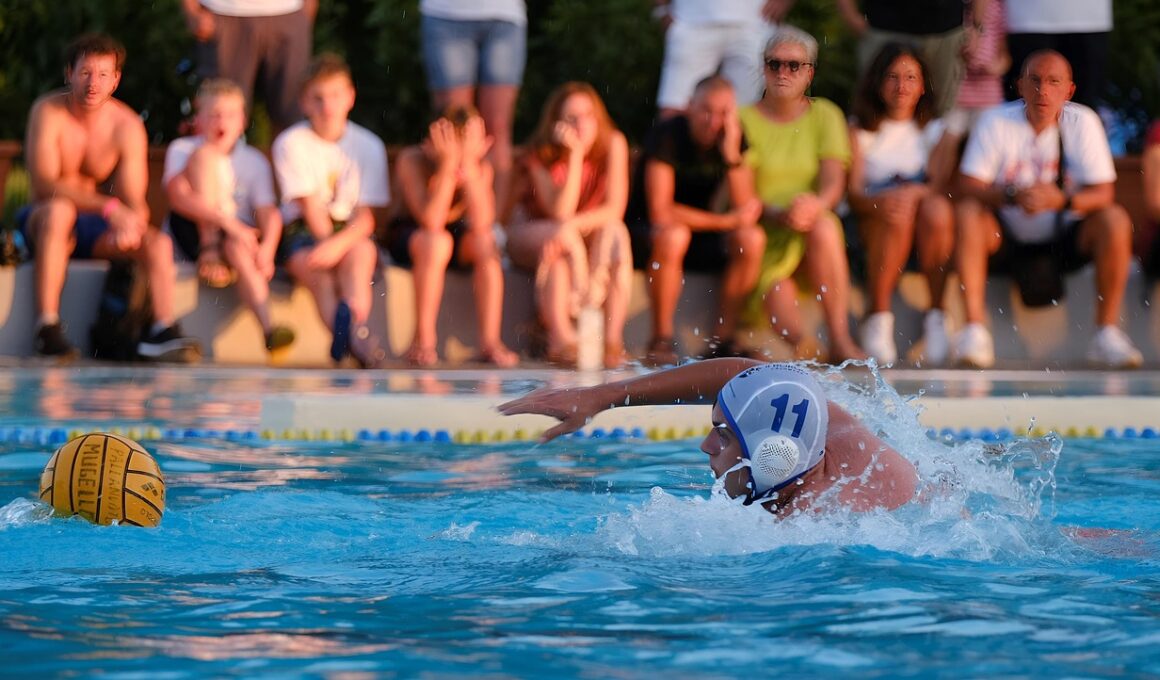Understanding the Water Polo Playing Field and Positions
Water polo is a unique and physically demanding aquatic sport played in a specially designed pool. The playing field is rectangular, typically measuring 20 by 30 meters, which allows ample space for both teams to maneuver. One goal is positioned at each end of the pool, each measuring 3 meters wide and 0.9 meters high. The pool must also maintain a depth of at least 1.8 meters, ensuring player safety and adequate movement. Players must swim, pass, and shoot while treading water, making it essential for them to enhance both swimming and ball-handling skills. The game consists of four quarters lasting eight minutes each, providing a fast-paced and competitive environment. Each team aims to score by throwing the ball into the opposing team’s goal. A match can witness numerous strategies and formations involving various player positions, including attackers, defenders, and goalkeepers. Successful teams often emphasize teamwork and tactical plays to outperform opponents. Understanding the layout of the playing field along with the specific rules is crucial for both players and spectators.
Water polo features seven active players from each team in play at any given time. These players are divided into categories, each fulfilling a distinct role. The positions include three drivers, three shooters, and one goalkeeper. Drivers are responsible for creating opportunities and finding space to evade defenders. They excel at swimming and maneuvering quickly, whilst also ensuring they support their teammates. Shooters, on the other hand, are tasked with scoring goals, and they often employ various strategies like fakes and power shots to outsmart the goalkeeper. Meanwhile, the goalkeeper plays a crucial role in defense, responsible for blocking shots while coordinating with defenders. Each position requires a unique blend of skills, stamina, and tactical awareness. Players must also possess excellent communication abilities, as passing and teamwork are vital during crucial moments of the game. The interchange between these roles can dictate the pace and outcome of the match, making adaptability a key attribute for any successful water polo athlete. Understanding these positions allows newcomers to appreciate the complexities of the sport and enhances their viewing experience.
The Importance of Team Formation
Effective play in water polo relies heavily on strategic team formation. Teams may adopt different formations depending on their strengths, weaknesses, and the opposing team’s tactics. One common formation is the 3-3 setup, comprising three players positioned at the front and three behind. This allows for a solid balance between offense and defense, enabling quick transitions. Another popular formation involves using a 2-4 configuration, which emphasizes a strong offensive line designed to apply pressure and create scoring opportunities. Furthermore, players must communicate continuously to adjust their positioning throughout the game. Water polo strategies often change rapidly, necessitating complete trust among teammates and quick decision-making skills. Understanding formations is critical, as it directly impacts how efficiently teams can maneuver both the ball and players. Teams that can fluidly shift their formations in reaction to the opponent’s tactics tend to excel during matches. Coaches play an essential role in teaching these formations, training athletes to execute them flawlessly under pressure. Overall, mastering team formations can significantly increase a team’s chance of succeeding during competitions.
In addition to strategic formations, understanding the various rules of water polo is essential for both players and fans. Familiarity with these rules can dramatically impact the game’s flow, including how fouls are assessed. Players must learn the difference between ordinary and exclusion fouls; for instance, an ordinary foul results in a free throw, while an exclusion foul forces a player out for 20 seconds, leaving a team short-handed. Neutral fouls can also influence gameplay by stopping the ball and resetting the game’s pace. Moreover, goals may only be scored from outside of the five-meter line, adding another layer of strategy to attacking plays. In particular, players need to assess the best angles and attempts for scoring, while defenders should focus on blocking those prime opportunities. Understanding these specific regulations can lead to a better appreciation for the skill required in mastering water polo. Ultimately, rules dictate the course of the game, and athletes must adapt their strategies accordingly to enhance their performance in matches.
Conditioning and Preparation
Preparing for water polo demands rigorous physical conditioning and practice. Players must develop stamina and strength to excel in this high-energy sport, as they engage in constant swimming and physical tussles with opponents. Most training regimens incorporate swimming drills to enhance overall speed and endurance in the water. Moreover, land workouts focusing on strength training and flexibility complemented with swimming drills can maximize performance. Core conditioning is vital, as a strong core aids in treading water and explosive movements during gameplay. Additionally, agility exercises help athletes fine-tune their quick movements necessary to dodge defenders or reposition effectively. Water polo players often participate in scrimmages, which simulate real-game scenarios to strategize and practice teamwork. Coaches frequently evaluate their players on technical skills, tactical understanding, and teamwork during these practice matches. Nutrition plays a significant role as well; athletes should maintain balanced diets to fuel their high-energy output. Ultimately, consistent training and preparation help water polo players build the skills necessary to thrive in matches and achieve their competitive goals.
The role of mental resilience cannot be understated in water polo. As this sport can be intense and demanding, players must cultivate a strong mental attitude to navigate challenges on and off the field. Developing concentration is essential since real-time decisions can greatly affect the game’s outcome. Athletes must also learn how to manage stress and remain calm under pressure, particularly during crucial moments of a match. Visualization techniques and mental rehearsal can aid players in mentally preparing for different game scenarios while boosting confidence levels. Coaches often discuss the importance of fostering a positive team environment to encourage collaboration and morale. A strong support system enhances teamwork and helps players maintain focus, minimizing distractions. Sports psychologists sometimes collaborate with teams to improve mental conditioning strategies. These practices not only contribute to better performance during matches but also promote overall well-being among athletes. As the sport evolves, it becomes increasingly clear that a balanced union between physical skill and mental acuity is vital for those keen on achieving success in competitive water polo.
Conclusion: The Path to Expertise
As players continue to develop their skills and deepen their understanding of water polo, they embark on a journey toward excellence. Mastering the playing field, positions, formations, and rules requires dedication, practice, and a willingness to adapt. Players must continually refine their technical skills, alongside mental and physical conditioning. Communication and teamwork are essential, allowing dynamics within the game to evolve and flourish. Observing professional games can provide invaluable insights about advanced strategies and techniques. Aspiring athletes are encouraged to engage with experienced mentors who can guide their growth and help accelerate their development. Through perseverance and commitment, players can achieve their goals in this demanding sport. In addition, staying updated with water polo advancements can enhance their tactical knowledge and emphasize the importance of sportsmanship. Embracing a holistic approach that considers conditioning, skills, mental resilience, and teamwork sets a solid ground for success. The excitement of water polo lies in its challenges and complexities, paving the way for players to leave a mark on the competitive stage. A dedicated journey leads to a profound understanding of the sport and its exhilarating essence.
The future of water polo is bright, with ongoing developments aiming to elevate the sport’s profile. Increased global interest has led to greater participation rates in youth programs, fostering a new generation of players. Various international governing bodies are diligently working to implement fresh ideas, such as rule modifications aimed at enhancing the game’s appeal. These changes aim to boost spectator engagement and expand the sport’s audience. Additionally, the rise of digital media has facilitated greater exposure for high-caliber competitions, attracting sponsorship and support. As a result, water polo leagues and events are gaining traction, bringing together both enthusiasm and talent. Grassroots initiatives are essential too; local clubs encourage young athletes to partake in the sport, helping them develop essential skills while promoting values like teamwork and camaraderie. Schools and educational institutions are increasingly recognizing water polo’s benefits, leading to more opportunities for students. Continued investment in facilities and training resources will enable players to train more effectively and reach their potential. Ultimately, this positive trajectory will ensure the longevity and growth of water polo across the globe.


